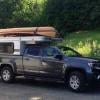You do not want to use spaceloft or any of the other aerogel insulations! They are essential a fiberglass batt, impregnated with an aerogel dust which gets everywhere and is horrible to work with, requiring gloves and dustmask. The batts are fairly stiff and would not work well for this application. I use this stuff for some very specific applications in a high altitude research project, and while it does work well, it is really unpleasant to be around unless it is fully encapsulated.
Also, consider the thermal loss out of the rest of the camper - there is no point insulating the soft sides more than the rest of the camper. I think the walls and roof of the camper have 1" foam insulation, but you need to add the conduction path through the frame, single pane windows and roof vents to the calculation, meaning the effective insulation is probably more like R-3 or R-4, so there is not much need to go above this for the soft sides. I have used 'warm window' insulation for a previous camper arctic pack, and it seemed to help a little, but did make the arctic pack more cumbersome:
Thanks for sharing your first hand experience working with Spaceloft. Watching the attached training guide the sheets look to be flexible and neither installer is wearing gloves or face masks. Is this the same material you've worked with ? But again, as you state just throwing an insulation blanket on the soft sides will not keep the camper from heat loss. This brings me back to my original concerns of what the gain would be of having an Arctic Pack.


















